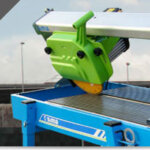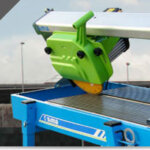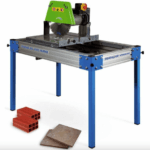Unlike other aspects of construction that require cutting, the biggest danger from cutting masonry materials (such as stone, tile, concrete, brick, etc.) is not risk of losing a finger to a whirring blade—it’s actually the dust that is produced from grinding through the stone. This dust contains something called microcrystalline silica, and inhaling it can cause severe and irreversible lung damage.
Because of this, most tile saws and masonry saws have some sort of built-in system to reduce the amount of dust that the operator and bystanders are exposed to. They can be broken down into two categories: wet cutting masonry saws and dry cutting masonry saws with a dust collection system.
How wet cutting masonry saws reduce dust exposure
The vast majority of common masonry tasks are suitable for wet cutting, and so most masonry saws and tile saws use water to keep dust from becoming airborne. For example, the DAKAR MEKANO 14” masonry saw has a water chamber built into the table of the bench saw. A 50W pump rests in the water chamber, and when the masonry saw is powered on for cutting, it pumps a continuous stream of water over the blade and the stone that is being cut.
Because of this, any dust that would be kicked up from the stone is immediately turned into a muddy slurry and washed into the table, keeping everyone nearby safe from harmful silica dust. As an added bonus, the water keeps the diamond blade cool, which extends the life of the blade, allows you to make longer and deeper cuts, and prevents potentially dangerous accidents that can occur as a result of an overheated blade.
Not all wet cutting masonry saws come with an integrated water tank and pump, however. In some cases, there will be an attachment on the saw to connect to a garden hose, which would, in turn, be connected to an external water supply such as an outdoor spigot.
How dustless masonry saws collect dust when dry cutting
There are very few circumstances in which wet cutting is not an option, but some people will have to resort to a dry cut for a particular job. Extra precautions always need to be taken when dry cutting, some of which are related to silica dust and some of which have to do with preventing the diamond blade from overheating.
For example, you must use a blade that is specifically indicated for dry cutting in these cases—wet cutting can be done with either a wet or a dry blade, but dry cutting can never be done with a diamond blade designed for wet cuts. Dry blades usually have slats cut out around the edge to promote air cooling of the blade, but this is never as effective as water cooling. Because of this, dry cuts can only be made in short, shallow passes, and so it can take longer to complete a job when dry cutting is used.
With regard to silica dust, a conventional masonry saw being used for dry cutting is very dangerous. Anyone operating the machine or working nearby must wear a respirator mask, and it must be done in a protected area if bystanders are present. For this reason, dustless masonry saws have begun coming onto the market, such as the SIMA Handy 14” tile saw. This is a tabletop model designed for portability, with a vacuum-assisted dust collection system. When dry cutting is absolutely necessary, this saw is the best option in terms of safety and convenience.
However, the bottom line is: when circumstances do not necessitate a dry cut, wet cutting is almost always preferable.





